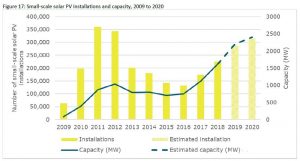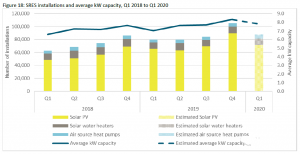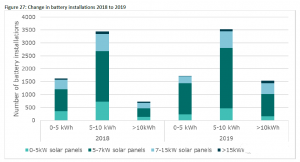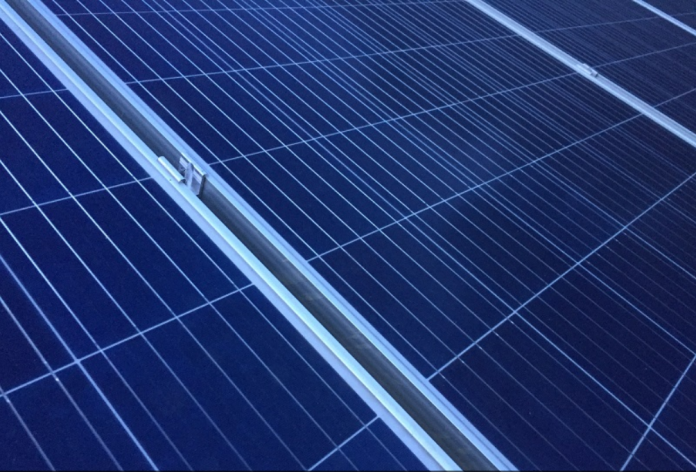Across Australia 6.3 gigawatts (GW) of new renewable energy capacity was delivered in 2019, up 24 per cent from the previous record set in 2018. Household and commercial rooftop solar PV grew by 40 per cent from 1.7 GW in 2018 to 2.4 GW in 2019; and utility scale by 18 per cent from 3.3 GW to 3.9 GW. A similar total capacity is expected to be delivered in 2020 – between 6.0 and 6.5 GW, although the mix will likely differ.
Total installed small-scale solar PV capacity for the quarter was 744 MW, a 41 per cent increase compared to the same quarter last year. The average kW capacity of small-scale solar PV systems increased by nine per cent from 7.2 kW in 2018 to 7.7 kW in 2019.
The increasing size of small-scale solar PV systems is contributing to higher STC creation rates.
In total, 10.3 GW of capacity has been installed under the Small-scale Renewable Energy Scheme (SRES) since its inception, with 99.9 per cent of capacity coming from small-scale solar PV and the remaining from small-scale wind and hydro. In 2019, an estimated 2.2 GW of small-scale solar PV capacity was installed nationally .
Solar PV capacity and installations are growing strongly, leading to increased supply of STCs in the market. Quarter 4 consistently has the highest number of installations. In Quarter 4 2019 installations increased 29 per cent and capacity by 39 per cent compared to Quarter 3 2019.
On average, small-scale solar PV system sizes have continued to increase . Average system size for all small-scale solar PV installations remains high at 8.3 kW for Quarter 4 2019. Large system size is a trend often seen in Quarter 4, as businesses make large installations before the yearly fall in the deeming rate.
System sizes 6.5 to 7 kW continue to dominate the market, balancing economies of scale with ease of network connection. However, system sizes 7 to 15 kW is a strong growth area, up 42 per cent from 2018 to 2019. This suggests that many households are finding ways to install systems that are not limited by 5 kW export limits most network service providers place on residential solar PV systems (or accept export limits capped at 5 kW). Batteries, preparation for electric vehicles and other technical solutions may be contributing to this trend. Section 6 explores in more detail the trends in battery installations with small-scale solar PV.
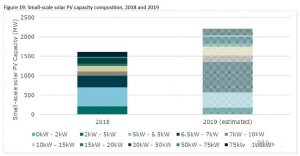 Concurrent battery installations are showing a trend towards larger sized batteries .The number of 0 to 5 kW hour (kWh) and 5 to 10 kWh batteries has remained relatively constant over the last two years. In contrast, the number of batteries with a capacity greater than 10 kWh has doubled from 2018 to 2019. This growth in larger capacity batteries may be promoted by the Australian Capital Territory and South Australian battery incentive schemes as they grant subsidies on a per kWh of battery capacity basis.
Concurrent battery installations are showing a trend towards larger sized batteries .The number of 0 to 5 kW hour (kWh) and 5 to 10 kWh batteries has remained relatively constant over the last two years. In contrast, the number of batteries with a capacity greater than 10 kWh has doubled from 2018 to 2019. This growth in larger capacity batteries may be promoted by the Australian Capital Territory and South Australian battery incentive schemes as they grant subsidies on a per kWh of battery capacity basis.
